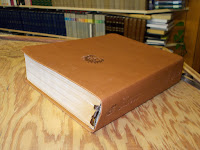Study Bibles for Expositors--Reformation Study Bible by Reformation Trust
Several months ago, I reviewed some study Bibles (Holman, NIV, ESV, Dugan, Hebrew-Greek Keyword) that I
found to be helpful for expositors. The
Bibles that I reviewed were primarily those that fell into a category of
general readership and those that were commonly found at large in big box
Christian bookstores. There are several
Bibles that I am going to write reviews of in the next few days that fall into
a variety of subsets of Christian doctrines and views. While some of these Bibles can be purchased
in big box stores, there are a few that you may have to track down through
on-line sources.
One of the areas that study Bibles have capitalized on in
the last several years has been Bibles that appeal to the Reformed
circles. The ESV Study Bible, the
MacArthur Study Bible, the Reformation Heritage Study Bible, and the
Reformation Study Bible are examples of that.
What we must understand with honesty is that publishing houses are
driven by the bottom line and whatever they can serve up to fill their coffers,
they are not hesitant to do so. That may
explain why they have really keyed in on the resurgence of Calvinism in the
last ten years. It has become one of the
fads of Christianity to hint at the fact that you are a Calvinist. Obviously if you are apostolic in doctrine,
you will be wholeheartedly opposed to the concepts of TULIP despite their somewhat
recent awakening among nominal Christianity.
The Reformation Study Bible in the English Standard Version
and New King James Version is published by Reformation Trust which is a
division of Ligonier Ministries. This is
the publishing arm of R.C. Sproul’s ministry in central Florida. R.C. Sproul is also the general editor of the
RSB. There was an earlier edition of
this Bible in the ESV back in 2005 prior to the ESV Study Bible. When the ESV Study Bible stormed the market
with its huge resources in footnotes, supplementary articles, book introduction
segments, and doctrinal inserts, the RSB sort of became second thought to those
enamored with the ESV Study Bible. So as
a response, Sproul gathered a team of Reformed heavy-weights and went back to
work and have developed an incredible resource for expositors. Again, to reiterate, I am NOT a Calvinist but
I do enjoy the various kinds of study Bibles, I picked one up and have
benefited from reading it. It comes in
at a little over 2500 pages and is a strong rival to the more diverse ESV Study
Bible as far as theology and doctrine.
I have the leather-like tan edition. It has a very unique symbol of the burning
bush on the front cover and the spine of the Bible. The symbol is representative of the
sufferings of the Reformers in the 16th century and forward. It was a church that was burning with
persecution but it was not consumed.
Most historians believe that it was first used by the Huguenots who
adopted this sign that they would not be burned to ashes. A positive matter about the study Bibles that
come from the Reformed circles is the emphasis that they place on the English
Bible having been brought to us by much pain and persecution. It was when I started reading in some of
these study Bibles that I became familiar with the work of John Wycliffe,
William Tyndale, and Thomas Rogers. They
all paid a great price to bring English translations to the world and I found
that my respect for these men grew in great bounds. If you are a reader, you would do yourself a
favor by reading some of the biographies of these men and their work.
The TOC section is followed by a listing of “Theological
Notes” that are scattered all throughout the RSB. There are almost eighty smaller length
articles that are contained in this study Bible. It covers a host of matters including—Original
Sin, The Holiness of God, Free Will, Hell, Repentance, and Heaven. They are easily located throughout the RSB because
they are contained in shaded gray boxes.
The font size is a bit small around an 8 point or so but has valuable
insight from the Reformed position.
Each book of the Bible has excellent introductions where
there is absolutely no equivocation as to the inerrancy and authority of
Scripture. The introductions will have
the following areas that are covered:
Title, Author, Date and Occasion, Genre, Literary Features,
Characteristics and Primary Themes, Theology of that particular book, the book
in the Larger Story of the Bible, Christ in that book, History of
Interpretation, and Special Issues. As
an example, the characteristics and primary themes of Leviticus are said to
be: 1. The Divine Presence, 2. Holiness,
and 3. Atonement through Sacrifice. After
the book introductions, there follows a fairly concise outline of the
book. Admittedly there are other study
Bibles that I thought gave better outlines but this is not a reason to forgo
having this study Bible. For that matter,
there is one other drawback about this Bible as well. The in-text maps are in black and white and
the font size of the maps looks to be around a 4-5 point which is incredibly
difficult to see without aid. That is
where the ESV Study Bible edges out the RSB.
In conclusion, I have found the RSB to be a helpful tool for
me in the preparation of expository messages and Bible studies although I
certainly would not recommend this Bible to a new-convert or someone who is not
spiritually mature. One other matter that
is worth mentioning, the purchaser receives a registration number that will add
around $400 of supplemental material that comes in the form of eBooks for
Kindle and other online resources.
Thanks for reading. . .










Comments